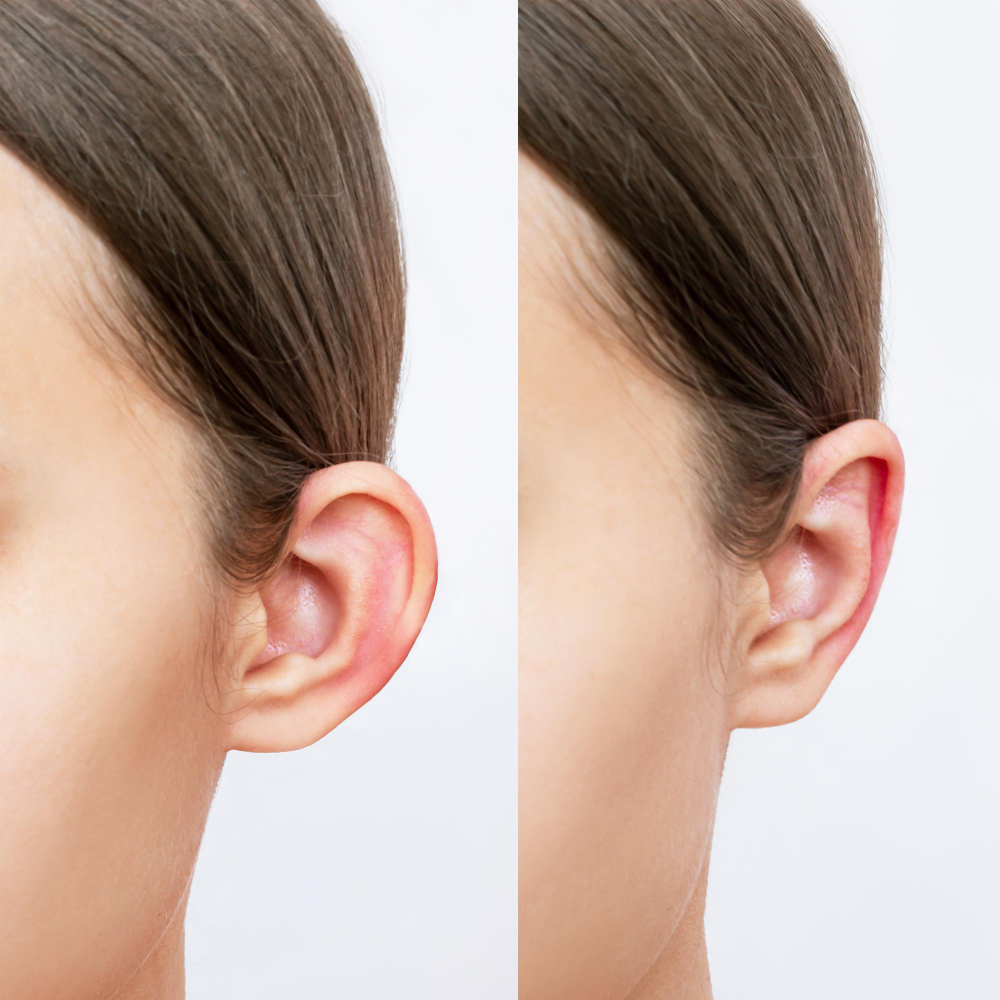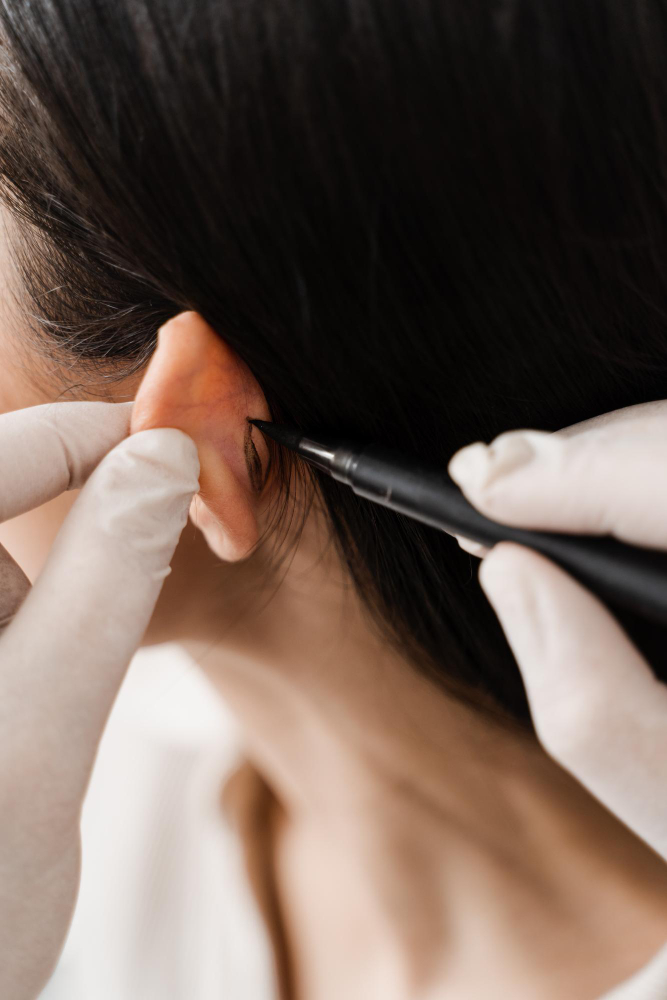Otoplasty (Ear Reshaping)
Otoplasty refers to a form of aesthetic surgery concentrating on the ears. In this procedure, a plastic surgeon has the capability to modify the size, position, or structure of your ears.
There are individuals who opt for otoplasty, aiming to rectify a structural anomaly that affects their ears. Meanwhile, others undergo this procedure due to a dislike for the protrusion of their ears from the head.
Continue reading to learn more about otoplasty, the typical recipients, and the details of the surgical process.

Why do people get otoplasty?
Individuals may choose to undergo otoplasty surgery if they were born with:
- Misshapen ears or ear lobes.
- Protruding ears.
- Small, constricted ears.
- Ears with missing cartilage.
The mentioned symptoms are conditions that someone is born with, as “congenital” indicates. However, otoplasty procedures are also carried out by surgeons on individuals who have experienced ear injuries or trauma in events that are distressing or violent, such as car accidents, dog attacks, or sports-related incidents.
Otoplasty may be suggested by your surgeon if you have endured permanent damage from cauliflower ear, which is a frequently occurring injury among boxers, wrestlers, and mixed martial artists.

Am I a good candidate for an Otoplasty?
Children who would be suitable candidates for ear surgery include:
- In good health, without a serious illness that could be fatal or unaddressed ongoing ear infections.
- Typically, at around the age of 5 or when a child’s ear cartilage has reached a stable condition suitable for correction.
- Cooperative and follow instructions well
- Capable of expressing emotions and refraining from objecting when the topic of surgery arises.
Adolescents and grown-ups who are suitable candidates for surgery on the ears are:
- People who are in good health and do not have a serious illness or medical issues that could slow down the healing process.
- People who have a positive attitude and have specific objectives in mind for getting ear surgery.
- Nonsmokers
The process of undergoing ear surgery is unique to each person, and it should be a decision made for personal reasons rather than to meet another person’s expectations or conform to a specific standard of appearance.
Types of Otoplasty

There are various types of otoplasty, including ear pinning surgery which aims to make protruding ears flat. In addition, surgeons can modify ears that are either too big or too small, repair damaged ears, and fix ear irregularities present from birth.
Types of otoplasty include:
- Ear augmentation is a method utilized to enhance the size of the external ear. It is commonly sought after by individuals with small ears or those whose ears have not fully grown to their regular size.
- Ear pinning is a cosmetic surgery procedure that aims to pull the ears closer to the head for individuals who have ears that protrude excessively from the sides of their heads.
- Ear reduction is a procedure aimed at reducing the size of larger-than-normal ears. Individuals with macrotia, a condition characterized by oversized ears, may opt for this elective surgery. The procedure may also involve reducing the size of the earlobes.
Otoplasty is a procedure that can be carried out on individuals of various age groups, including adults.
Things to consider before otoplasty
Prior to deciding on otoplasty, it is crucial to consider certain key factors.
- In order to create better symmetry, it is common for surgeries to be conducted on both ears even if only one appears to protrude.
- It is improbable to achieve absolute symmetry. Like natural ears, the position of the ears after otoplasty will not be perfectly identical.
- Consider the monetary burden involved. While Medicare and private health insurance might partially cover certain expenses, you should anticipate some expenses that you will have to pay yourself.
- Inquire with your healthcare provider regarding any personal expenses you may anticipate and if you qualify for a reimbursement.
- Those who smoke have a higher chance of experiencing complications. In order to lower the likelihood of complications and improve your overall health, it is advisable to quit smoking prior to undergoing surgery.
- It is advisable to seek an additional perspective from another healthcare professional before making the decision to undergo otoplasty. Gathering as much information as possible beforehand is crucial.
What happens during otoplasty?

Typically, Otoplasty is a procedure that does not require overnight stay, allowing patients to return home on the same day.
Your healthcare provider will administer anesthesia before surgery starts to ensure your comfort. This may be in the form of general anesthesia, inducing complete sleep, or local anesthesia with sedation, making you drowsy but still able to answer questions.
The specific surgical procedures differ depending on the type of otoplasty you are undergoing. Some general steps involved are as follows:
- Creating a cut, typically located at the rear or within the creases of your ear.
- Adding or removing tissue to your ear.
- Reshaping your ear.
- Closing the incision with stitches.
Recovery
Day of Surgery
- After leaving the hospital or surgical center, it will be necessary for you to have someone accompany you back home and give you a ride.
- Rest in bed with head elevated
- Recover from anesthetic
- Start taking the antibiotics or pain medication that your doctor has prescribed.
First Week after Surgery
- Ears will be a little red and swollen
- Do not sleep on your side
- Your doctor might examine bandages and the process of healing.
- Continue any prescribed medications
- Keep the bandages on and secure them with a headband to keep the ears in the desired position.
Following Weeks
- The purpose of a headband was originally to shield the ears, but its usage has decreased.
- Ongoing enhancement of the condition involving inflammation and puffiness.
- Carefully clean the area as instructed
- Stitches removed if necessary
- Topical ointments may be prescribed
- Go back to work or school in approximately a week and gradually begin resuming normal daily tasks.
- Make sure to heed all post-treatment guidelines attentively.
What are the benefits of otoplasty?
Otoplasty provides significant advantages, such as:
- Fixing ears that stick out, are prominent, or have an unusual shape.
- Increased self-confidence.
- Safe treatment.
- Permanent results.
Having otoplasty in Turkey?
The patient must carefully search for an appropriate service provider, have information, and ask about the surgeon and his experience. And also, checking examples of his previous operations.
Accordingly, we encourage you to contact the Health & Beauty to obtain all information and details, and to ensure that you have your operation done by the hands of the most skilled doctors working in this specialty.
